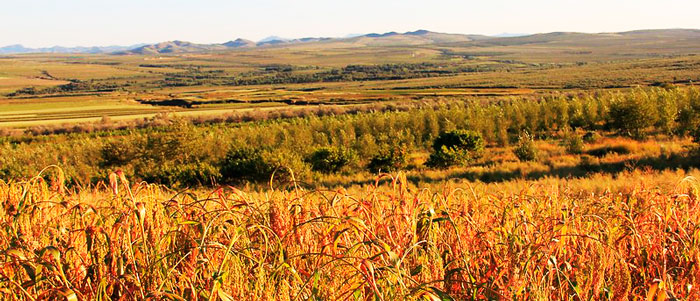Aohan Dryland Farming System, China
GIAHS since 2012

Detailed Information
Site location: Aohan County, Chifeng City, Inner Mongolia Autonomous Region, P.R. China
Area of GIAHS: 8294 km2
Population working for this system: -
Topological Characteristics: dry lands
Climatic Classification: dry climate
Ethnic Groups/Indigenous People: Mongolian (5.34%), Manchu (1.11%), Hui (0.29%), Han (93.21%)
Primary Income Sources: agriculture
---------------------------------------------------------------------------------------
Global importance
Xinglongwa in Aohan County have been cultivating grains for more than 7500 years. As a result, many skills and experiences have been accumulated over the long years of farming practice, and unique local dry farming cultures have been formed, including farming proverbs, food cultures and seasonal customs.
Traditionally, different crops are interplant with rotations combining arable crops and soil improving crops, such as the rotation planting of broomcorn millets--potatoes--grains--beans--broomcorn millets. Traditional farming technique using cows and human labor has been applied for thousands of years. Concerning the irrigation and soil management, different techniques aiming to reduce evaporation and save resources have been developed.
Nevertheless, due to the effects of modern economic, social, and value changes, this traditional farming culture is facing threats and challenges from various sources. It is urgent to explore the values of this important system and protecting it in a dynamic way.
Food and livelihood security
Aohan County is an important crop production area which forms an agriculture structure that combines farming, forestry and animal husbandry together. It is a typical dry farming area and abounds with green grains such as foxtail millet, broomcorn millet, buckwheat, sorghum, beans, etc.
In 2010, the total yield was 0.8 billion kg. In 2008, the total production of meat reached 100,085 tons, milk 19,016 tons, wool 3,557 tons, and 1,598 million livestock animals. Aohan County is the main source of income for the communities in this region where 90% are rural population.
Biodiversity and ecosystem functions
Aohan County is a typical dry farming area with a wide variety of crop types with foxtail millet and broomcorn millet as representatives. This System also includes corn, sorghum, wheat, barley, buckwheat, and rice; soybeans, black beans, lima beans, peas, broad beans, cowpea, red beans, green beans, and kidney beans; economic crops such as peanuts, rapeseed, sesame, sunflower, castor, flax, tobacco, fruits, vegetables and animals.
In terms of ecosystem functions, this system possess the function of wind prevention and sand stabilization. Aohan people have continued to plant grass and trees to prevent wind and fix sand since the People's Republic of China was founded in 1949. In addition, due to the topographical differences between north and south, there are 2 forms of soil erosion. The Aohan people took their efforts to control the soil erosion over the past decades and significantly improved agricultural production conditions and environment.
Knowledge systems and adapted technologies
Traditionally, different crops are interplant with rotations in the Aohan Dryland Farming system. Rotation is a scientific system that combines arable crops and soil improving crops, such as the rotation planting of broomcorn millets--potatoes--grains--beans--broomcorn millets, where broomcorn millets are cultivated every four years.
Foxtail and broomcorn millets are not suitable for mechanical operations because of their small plant types and area. Traditional farming technique, which uses cows and human labour, has been applied in the system for thousands of years. Different traditional tools are used for the cultivation tasks than the process of the grains.
Concerning watering, farmers alternatively irrigate one side of the crop roots each time. This not only can control over irrigation and water lost, but also send signals to the dry side of the roots to control evaporation while the wet side absorb water, so as to avoid leakage and fertilizer lost.
Cultures, value systems and social organizations
Unique local dry farming culture of Aohan County was formed by a long term farming practice. Folk songs, techniques and other custom cultures have been inherited from one generation to another. The people of Aohan County recorded many farming proverbs over the long process of fighting against nature.
Farming cultures is the site and each activity is closely connected to farming, from the sacrifice activities in ancient times to the custom of blessing in modern times including grain spreading and worshiping in hopes of fortune and good weather.
Remarkable landscapes, land and water management features
In Aohan County, dryland crops such as foxtail millet and broomcorn millet, can be seen everywhere, which became a special sightseeing of the Aohan Dryland Farming System. Cultivating in terraces system, this agricultural landscape have been shaped for centuries and integrated to its environment.
Concerning land and water management, during dry seasons, sets of farming techniques such as interplanting and replacing plowing with softer soils, can increase the depth of water penetration and moisture level which results in the reduction of water usage. Moreover, covering the soil could reduce evaporation and run-off as well as increase moisture and ground temperature. Aohan people have continually planted grass and trees to prevent wind and fix sand.

